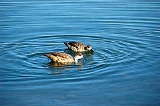
Crested Duck
Encyclopedia
The Crested Duck is a species
of duck
native to South America
, the only member of the monotypic
genus
Lophonetta. It is sometimes included in Anas, but it belongs to a South America
n clade
that diverged early in dabbling duck evolution
(Johnson & Sorenson, 1999). There are two subspecies: L. specularioides alticola (Andean Crested Duck
) and L. specularioides specularioides (Patagonian Crested Duck
). The Patagonian Crested Duck is also called the Southern Crested Duck and its range lies in the Falklands, Chile
, and Argentina
.
It feeds on invertebrates and algae
, and prefers shallow coastal regions. It nests in tall grass
near water and lays 5 to 7 egg
s.
Species
In biology, a species is one of the basic units of biological classification and a taxonomic rank. A species is often defined as a group of organisms capable of interbreeding and producing fertile offspring. While in many cases this definition is adequate, more precise or differing measures are...
of duck
Duck
Duck is the common name for a large number of species in the Anatidae family of birds, which also includes swans and geese. The ducks are divided among several subfamilies in the Anatidae family; they do not represent a monophyletic group but a form taxon, since swans and geese are not considered...
native to South America
South America
South America is a continent situated in the Western Hemisphere, mostly in the Southern Hemisphere, with a relatively small portion in the Northern Hemisphere. The continent is also considered a subcontinent of the Americas. It is bordered on the west by the Pacific Ocean and on the north and east...
, the only member of the monotypic
Monotypic
In biology, a monotypic taxon is a taxonomic group with only one biological type. The term's usage differs slightly between botany and zoology. The term monotypic has a separate use in conservation biology, monotypic habitat, regarding species habitat conversion eliminating biodiversity and...
genus
Genus
In biology, a genus is a low-level taxonomic rank used in the biological classification of living and fossil organisms, which is an example of definition by genus and differentia...
Lophonetta. It is sometimes included in Anas, but it belongs to a South America
South America
South America is a continent situated in the Western Hemisphere, mostly in the Southern Hemisphere, with a relatively small portion in the Northern Hemisphere. The continent is also considered a subcontinent of the Americas. It is bordered on the west by the Pacific Ocean and on the north and east...
n clade
Clade
A clade is a group consisting of a species and all its descendants. In the terms of biological systematics, a clade is a single "branch" on the "tree of life". The idea that such a "natural group" of organisms should be grouped together and given a taxonomic name is central to biological...
that diverged early in dabbling duck evolution
Evolution
Evolution is any change across successive generations in the heritable characteristics of biological populations. Evolutionary processes give rise to diversity at every level of biological organisation, including species, individual organisms and molecules such as DNA and proteins.Life on Earth...
(Johnson & Sorenson, 1999). There are two subspecies: L. specularioides alticola (Andean Crested Duck
Andean Crested Duck
The Andean Crested Duck is one of two subspecies of the Crested Duck. It is much rarer than its sibling subspecies, the Patagonian Crested Duck.-Description:...
) and L. specularioides specularioides (Patagonian Crested Duck
Patagonian crested duck
The Patagonian Crested Duck , also known as the Southern Crested Duck, or the Grey Duck in the Falkland Islands, is the nominate of two subspecies of the Crested Duck.-Description:...
). The Patagonian Crested Duck is also called the Southern Crested Duck and its range lies in the Falklands, Chile
Chile
Chile ,officially the Republic of Chile , is a country in South America occupying a long, narrow coastal strip between the Andes mountains to the east and the Pacific Ocean to the west. It borders Peru to the north, Bolivia to the northeast, Argentina to the east, and the Drake Passage in the far...
, and Argentina
Argentina
Argentina , officially the Argentine Republic , is the second largest country in South America by land area, after Brazil. It is constituted as a federation of 23 provinces and an autonomous city, Buenos Aires...
.
It feeds on invertebrates and algae
Algae
Algae are a large and diverse group of simple, typically autotrophic organisms, ranging from unicellular to multicellular forms, such as the giant kelps that grow to 65 meters in length. They are photosynthetic like plants, and "simple" because their tissues are not organized into the many...
, and prefers shallow coastal regions. It nests in tall grass
Grass
Grasses, or more technically graminoids, are monocotyledonous, usually herbaceous plants with narrow leaves growing from the base. They include the "true grasses", of the Poaceae family, as well as the sedges and the rushes . The true grasses include cereals, bamboo and the grasses of lawns ...
near water and lays 5 to 7 egg
Egg (biology)
An egg is an organic vessel in which an embryo first begins to develop. In most birds, reptiles, insects, molluscs, fish, and monotremes, an egg is the zygote, resulting from fertilization of the ovum, which is expelled from the body and permitted to develop outside the body until the developing...
s.

